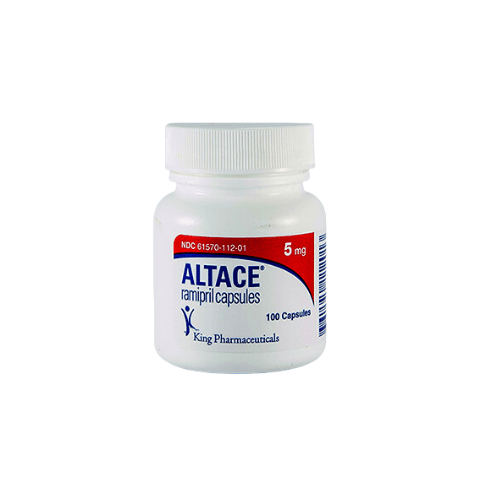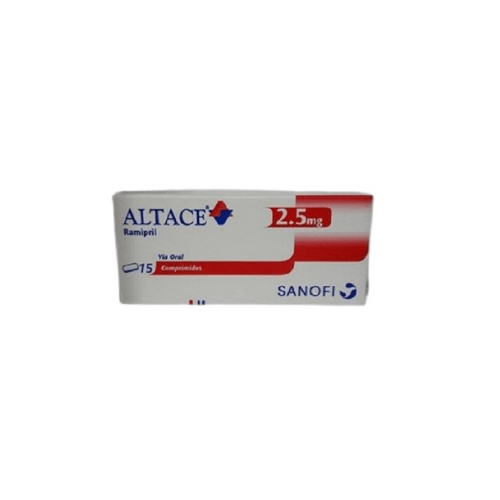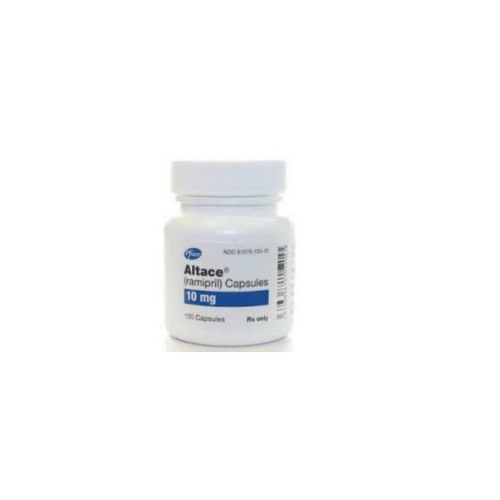Please note: a valid prescription is required for all prescription medication.
Altace® Tablets for Hypertension
Sitewide Super Sale - Get 15% off when you buy 3 or more of the same product using the code LESS15 at checkout.
Applies to all products originating from Canada. Maximum quantity limited to a 90-day supply per order.
Price range: $70.90 through $104.40
You save


What Altace Is and How It Works
Altace® is the brand name for ramipril, an angiotensin-converting enzyme (ACE) inhibitor used to lower blood pressure and reduce cardiovascular risk. It helps relax blood vessels by limiting angiotensin II production and decreasing aldosterone activity. This improves blood flow and may reduce the workload on the heart. Eligible US patients can access this medicine with US delivery from Canada, including options for those paying Altace 10 mg without insurance.
CanadianInsulin.com is a prescription referral platform. We verify prescriptions with your prescriber when required, and licensed Canadian pharmacies dispense your order.
After oral dosing, ramipril is converted to its active metabolite, ramiprilat. The treatment reduces vasoconstriction and may lower afterload, which supports blood pressure control. It is commonly used for primary hypertension and can be prescribed to lower the risk of heart attack, stroke, or death in high-risk patients. It is also used to improve survival post–myocardial infarction, with or without clinical heart failure.
For a deeper overview of how this ACE inhibitor supports heart and vascular health, see our article on Altace Supports Heart Health. You can also review related condition pages such as Hypertension to learn about lifestyle measures that complement therapy.
Who It’s For
This medicine is indicated for adults with essential hypertension. It may be used alone or combined with other antihypertensives to reach targets aligned with your care plan. Clinicians may also use it to reduce cardiovascular events in high-risk individuals and to support outcomes after a heart attack.
Do not use during pregnancy; ACE inhibitors can harm the fetus. Avoid use if you have a history of ACE inhibitor–related angioedema or known hypersensitivity to any component. People with significant renal artery stenosis, severe kidney impairment, or hyperkalemia require careful evaluation. Those with heart failure should discuss the Heart Failure care path and monitoring needs with their prescriber.
Dosage and Usage
Follow the prescribing information and your clinician’s instructions. For hypertension, typical starting regimens are once daily, with titration based on response and tolerability. Some patients may use divided dosing if advised. With or without food is generally acceptable; choose a consistent time each day.
Titration aims for adequate blood pressure control without undue side effects. In certain scenarios, your care team may target ramipril 10 mg daily as a maintenance dose. Post–myocardial infarction and heart failure protocols can involve cautious up-titration with close monitoring of blood pressure, kidney function, and potassium. Always review the official label for condition-specific schedules.
Hydration status can affect first-dose responses. If you are volume-depleted due to diuretic use or illness, your prescriber may address this before initiating therapy. Report symptoms such as dizziness, lightheadedness, or faintness promptly.
Strengths and Forms
This therapy is available as oral tablets in multiple strengths. Availability can vary by pharmacy and market. Commonly listed strengths include 1.25 mg, Altace 2.5 mg, 5 mg, and 10 mg tablets.
Tablets are typically taken once daily, though some regimens split doses. Your prescriber will determine strength and titration based on blood pressure goals, comorbidities, and concurrent medications.
Missed Dose and Timing
If you miss a dose, take it when you remember the same day. If it is near the next scheduled time, skip the missed dose and resume your usual schedule. Do not double up to make up for a missed dose.
Consistency matters. Taking it at the same time each day can help stabilize results and simplify your routine. If you experience low blood pressure symptoms, sit or lie down and contact your care team for guidance.
Storage and Travel Basics
Store tablets at room temperature in a dry place, away from excessive heat and moisture. Keep the bottle tightly closed and out of reach of children and pets. Do not store in bathrooms where humidity fluctuates.
When traveling, carry your medication in original labeled packaging. Pack enough for the entire trip and a small buffer in case of delays. A copy of your prescription and a medication list can simplify security checks and care coordination. If flying, keep medicine in your carry-on to avoid extremes of temperature.
Pill organizers may help with adherence. Confirm the imprint and strength before placing tablets in an organizer to avoid mix-ups. An encrypted checkout and careful handling help protect your data and your medicine from order to arrival.
Benefits
As an ACE inhibitor, this treatment lowers blood pressure by reducing vasoconstriction and limiting aldosterone effects. Lower pressure can reduce the risk of cardiovascular events when used as directed. For those with recent myocardial infarction, therapy may support survival and reduce subsequent events.
Once-daily dosing is common, which can improve routine adherence. It can be combined with diuretics, calcium-channel blockers, or beta-blockers when combination therapy is appropriate.
Side Effects and Safety
- Dry cough: persistent tickling cough may occur
- Dizziness or lightheadedness: especially after the first doses
- Headache and fatigue: usually mild and transient
- Hypotension: more likely if volume-depleted or on diuretics
- Nausea or gastrointestinal upset: may improve with time
- Elevated potassium: risk increases with supplements or sparing diuretics
Serious but less common risks include angioedema of the face, lips, tongue, or throat; significant kidney function changes; and severe hypotension. Stop the medicine and seek urgent care for swelling of the mouth or throat, trouble breathing, or fainting. This drug should not be used during pregnancy. Discuss any history of hereditary angioedema with your clinician before starting therapy.
Drug Interactions and Cautions
Review all medicines and supplements with your prescriber. Potassium supplements, potassium-sparing diuretics, and salt substitutes containing potassium can raise potassium levels. Nonsteroidal anti-inflammatory drugs (NSAIDs) may blunt antihypertensive effects and impact kidney function, especially in older adults or those with dehydration.
Concomitant use with other agents that affect the renin–angiotensin system requires caution. Avoid aliskiren in patients with diabetes. Combining with ARBs or direct renin inhibitors is generally discouraged due to increased risks. Lithium levels may increase; monitor if used together.
What to Expect Over Time
Blood pressure responses can emerge as you reach a steady regimen. Your clinician may check serum creatinine and potassium after starting or changing the dose. Cough, if it occurs, often appears weeks into therapy; report persistent symptoms.
Adherence is key. Use a daily routine, set reminders, and refill before you run out. If targets are not reached, your care team may adjust the dose or add another class. For education on the medicine’s roles and prevention benefits, see our overview on Ramipril Uses.
Compare With Alternatives
Other ACE inhibitors may be appropriate if cough or other effects limit tolerance. Your prescriber might consider an alternative such as Enalapril if a class substitute is preferred. When an ACE inhibitor is not suitable, an angiotensin receptor blocker like Valsartan may be selected based on clinical history and goals.
Pricing and Access
Canadian pharmacy pricing may help reduce out-of-pocket spend compared with some local cash rates. Check the Altace 10 mg price on our product page to compare options and plan your order. We offer transparent selection of strengths with secure checkout and US shipping from Canada.
If you are looking for active deals, visit our Promotions page for current offers and terms. Final payment and fulfillment depend on a valid prescription and product availability.
Availability and Substitutions
Market availability can change based on supply, strength, and manufacturer. If a specific tablet is temporarily unavailable, such as Altace 5 mg, your prescriber may recommend a therapeutically appropriate alternative strength or a different ACE inhibitor.
Pharmacies may dispense a generic equivalent when indicated on the prescription. Your clinician can advise on substitutions and whether a particular manufacturer is preferred for continuity.
Patient Suitability and Cost-Saving Tips
This therapy may suit adults with essential hypertension, high cardiovascular risk, or post–myocardial infarction needs when an ACE inhibitor is appropriate. It may not suit patients with pregnancy plans, prior angioedema, or severe kidney disease. Ask about lab monitoring and home blood pressure tracking.
To lower overall costs, consider longer refills if your prescriber agrees. Align refills with your calendar and set reminders. If your clinician approves a generic, prices are often lower; many patients choose to buy ramipril 10 mg for budget reasons. Compare brand and generic options before checkout.
Questions to Ask Your Clinician
- Starting dose: what dose and schedule are planned?
- Monitoring: how often to check blood pressure and labs?
- Combination therapy: when to add a second agent?
- Side effects: what to do if cough develops?
- Potassium: should I avoid supplements or salt substitutes?
- Travel: how to manage refills while away?
Authoritative Sources
For complete prescribing details and safety information, consult official references before use. The FDA label on DailyMed provides comprehensive content for clinicians and patients; you can review the current monograph on DailyMed Ramipril Label. Canadian regulatory information is available through Health Canada’s Drug Product Database; see the entry for ramipril in the Health Canada DPD. Manufacturer-produced resources may also offer patient-friendly guides; refer to your product’s insert or the company site when available.
Ready to proceed? Order through CanadianInsulin for prompt, express shipping with temperature-controlled handling when required.
Medical disclaimer: This content is for informational purposes only and is not a substitute for professional medical advice.
Express Shipping - from $25.00
Shipping with this method takes 3-5 days
Prices:
- Dry-Packed Products $25.00
- Cold-Packed Products $35.00
Standard Shipping - $15.00
Shipping with this method takes 5-10 days
Prices:
- Dry-Packed Products $15.00
- Not available for Cold-Packed products
Is this medicine the same as ramipril?
Yes. Ramipril is the generic name for the active ingredient in this ACE inhibitor. Pharmacies may dispense a generic version if your prescription allows substitution.
Can I take it with food?
You can take the tablet with or without food. Choose a consistent time each day and follow your prescriber’s instructions.
What if I develop a persistent cough?
A dry cough can occur with ACE inhibitors. Report persistent symptoms to your clinician, who may adjust therapy or consider another class if needed.
Are lab tests needed during treatment?
Clinicians often check kidney function and potassium after starting or changing the dose. Monitoring frequency depends on your health status and other medicines.
Can I use potassium supplements or salt substitutes?
Avoid potassium products unless your prescriber approves them. Combining these with an ACE inhibitor can raise potassium to unsafe levels.
Is it safe during pregnancy or breastfeeding?
ACE inhibitors are contraindicated in pregnancy due to fetal risk. Discuss breastfeeding considerations with your clinician, as risk–benefit decisions are individualized.
How long should I continue therapy?
Use as directed by your clinician. Do not stop suddenly without guidance. Your care plan is individualized based on response, tolerability, and long-term risk reduction.
Rewards Program
Earn points on birthdays, product orders, reviews, friend referrals, and more! Enjoy your medication at unparalleled discounts while reaping rewards for every step you take with us.
You can read more about rewards here.
POINT VALUE
How to earn points
- 1Create an account and start earning.
- 2Earn points every time you shop or perform certain actions.
- 3Redeem points for exclusive discounts.
You Might Also Like
Related Articles
Zepbound storage: Keep It Safe With Clear Temperature Rules
This guide explains Zepbound storage so your medication stays effective. You will learn temperature limits, how long doses can stay unrefrigerated, travel practices, and what to do if a pen…
Zepbound and Fatigue: Practical Tips to Ease Tiredness Safely
Feeling drained after starting tirzepatide can be unsettling. Many users describe a mix of low energy, mild aches, and disrupted sleep early on. If you are navigating Zepbound and fatigue,…
Mounjaro Heart Benefits Beyond Weight Loss: What Matters
Key Takeaways Beyond weight: Heart-related effects may involve blood sugar, blood pressure, and inflammation. Evidence is evolving: Large outcome trials help clarify real-world heart risk. Heart rate can rise: Small…
Ozempic Rebound: A Practical Guide to Prevent Weight Regain
Many people stop GLP-1 therapy and wonder what comes next. Appetite changes, routine shifts, and metabolism can collide. A clear plan helps you keep progress steady and predictable, not reactive.…



